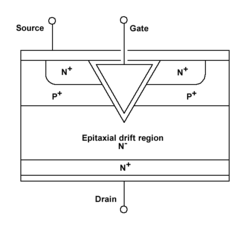VMOS
A VMOS (/ˈviːmɒs/) transistor is a type of MOSFET (metal-oxide-semiconductor field-effect transistor). VMOS is also used for describing the V-groove shape vertically cut into the substrate material. VMOS is an acronym for "vertical metal oxide semiconductor", or "V-groove MOS".[1]

The "V" shape of the MOSFET's gate allows the device to deliver a higher amount of current from the source to the drain of the device. The shape of the depletion region creates a wider channel, allowing more current to flow through it.
During operation in blocking mode, the highest electric field occurs at the N+/p+ junction. The presence of a sharp corner at the bottom of the groove enhances the electric field at the edge of the channel in the depletion region, thus reducing the breakdown voltage of the device.[2] This electric field launches electrons into the gate oxide and consequently, the trapped electrons shift the threshold voltage of the MOSFET. For this reason, the V-groove architecture is no longer used in commercial devices.
The device's use was a power device until more suitable geometries, like the UMOS (or Trench-Gate MOS) were introduced in order to lower the maximum electric field at the top of the V shape and thus leading to higher maximum voltages than in case of the VMOS.
History
The first MOSFET (without a V-groove) was invented by Mohamed Atalla and Dawon Kahng at Bell Labs in 1959.[3] The V-groove construction was pioneered by Jun-ichi Nishizawa in 1969,[4] initially for the static induction transistor (SIT), a type of JFET (junction field-effect transistor).[5]
The VMOS was invented by Hitachi in 1969,[6] when they introduced the first vertical power MOSFET in Japan.[7] T. J. Rodgers, while he was a student at Stanford University, filed a US patent for a VMOS in 1973.[8] Siliconix commercially introduced a VMOS in 1975.[6] The VMOS later developed into what became known as the VDMOS (vertical DMOS).[9]
In 1978, American Microsystems (AMI) released the S2811.[10][11] It was the first integrated circuit chip specifically designed as a digital signal processor (DSP), and was fabricated using VMOS, a technology that had previously not been mass-produced.[11]
References
- Holmes, F.E.; Salama, C.A.T. (1974). "VMOS—A new MOS integrated circuit technology". Solid-State Electronics. 17 (8): 791–797. Bibcode:1974SSEle..17..791H. doi:10.1016/0038-1101(74)90026-4.
- Baliga, B. Jayant (2008), "Power MOSFETs", Fundamentals of Power Semiconductor Devices, Springer US, pp. 276–503, doi:10.1007/978-0-387-47314-7_6, ISBN 9780387473130
- "Rethink Power Density with GaN". Electronic Design. 21 April 2017. Retrieved 23 July 2019.
- Duncan, Ben (1996). High Performance Audio Power Amplifiers. Elsevier. pp. 178 & 406. ISBN 9780080508047.
- U.S. Patent 4,295,267
- "Advances in Discrete Semiconductors March On". Power Electronics Technology. Informa: 52–6. September 2005. Archived (PDF) from the original on 22 March 2006. Retrieved 31 July 2019.
- Oxner, E. S. (1988). Fet Technology and Application. CRC Press. p. 18. ISBN 9780824780500.
- U.S. Patent 3,924,265
- Duncan, Ben (1996). High Performance Audio Power Amplifiers. Elsevier. pp. 177-8, 406. ISBN 9780080508047.
- "1979: Single Chip Digital Signal Processor Introduced". The Silicon Engine. Computer History Museum. Retrieved 14 October 2019.
- Taranovich, Steve (August 27, 2012). "30 years of DSP: From a child's toy to 4G and beyond". EDN. Retrieved 14 October 2019.